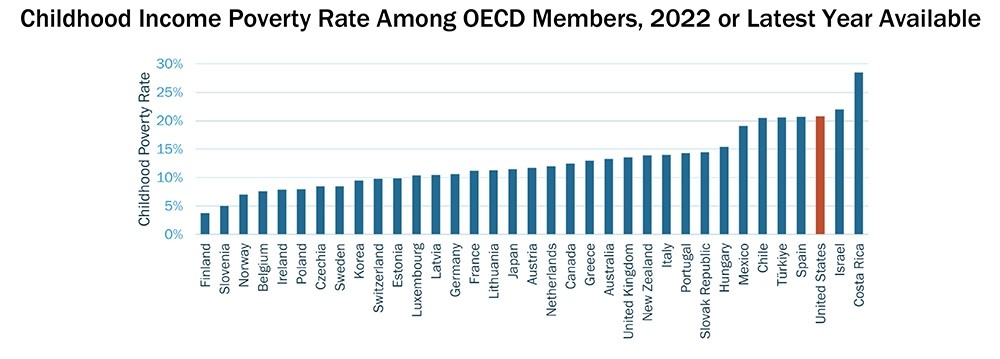How Money Matters: Education Funding and Student Outcomes
A large and growing body of evidence shows that money, when spent equitably and effectively on key school resources, improves student outcomes and closes achievement and opportunity gaps. Research consistently shows that when more money is spent on education, especially for students from low-income families, achievement and graduation rates improve, along with life outcomes such as employment and wages.
What factors influence education funding in the United States?
In the U.S., public schools are primarily funded by state and local governments. Local funding comes from property taxes, favoring wealthier areas, while federal funds (about 8%) support programs targeted to student needs, like Title I and special education. States allocate funds using various formulas—some aiming to balance inequities and others relying more on unequal local property taxes.
High child poverty and a tattered safety net. U.S. schools face unique challenges to provide a high-quality education— costs that schools in other industrialized nations often do not bear. First, the U.S. has one of the highest child poverty rates among countries in the Organisation for Economic Co-operation and Development (OECD). Additionally, compared to peers in other industrialized nations, U.S. children living in poverty have less access to social supports such as universal health care, housing subsidies, and universally available high-quality preschool. As a result, U.S. schools carry a larger share of the responsibility—and costs—for ensuring students have the necessary supports to learn and grow.

[Data set]. (accessed 04/07/2025).
Deeply inequitable school funding. Public schools in the United States are among the most inequitably funded of any industrialized nation, with schools and districts experiencing significant funding disparities due in large part to reliance on local property taxes. State funding rarely equalizes disparities. In fact, only 18 states provide at least 10% more funding to high-poverty districts than low-poverty districts, and nearly one third provide less funding to high-poverty school districts than low-poverty districts. On average, school districts serving the highest proportions of students of color receive $2,700 less per student in state and local funding compared to those with the fewest students of color. The federal government provides some support through Title I and other programs to help address these disparities. However, the federal share of K–12 education funding has declined over the past 50 years, falling to 8% as of 2019-20.
Rising costs of health care and pensions. Unlike many other industrialized nations, U.S. public schools are responsible for funding employee health care and retirement benefits. Personnel costs comprise 77% of public school expenditures, with 51% allocated to teacher salaries and benefits. Nationwide, health care spending has grown tenfold over the past 50 years, and retirement obligations for K–12 employees are also rising.
A student population with growing needs. Over the past decade, the share of low-income, special education, homeless, and English learner students has grown. Research has shown that more funding is needed to help students with higher needs reach state standards.
What does research on education funding reveal?
Decreases in education funding
Research shows that student outcomes are adversely impacted when education funding is cut. Funding cuts during the Great Recession were detrimental to educational achievement, including:
-
Students in states with significant education budget cuts experienced lower test scores and decreased college enrollment rates.
-
On average, a $1,000 reduction in per-student spending widened the achievement gap between Black and White students by 6 percentage points.
-
A key factor behind these negative effects was the loss of teachers—the most influential in-school factor affecting student learning. The teacher workforce shrank by more than 100,000 during the recession, and as of the 2021–22 school year, it had yet to return to pre-recession levels.
Increases in education funding
Well-allocated increases in education funding improve student outcomes. Research shows:
Federal pandemic relief funding had positive effects on student achievement. The positive effects of the funds between 2022 and 2024 included:
-
Greater academic improvements in math and reading in high-need districts that received larger federal allocations than similar districts that received less funding.
-
Greater achievement gains in districts that allocated more federal funds to academic interventions, such as tutoring and summer school programs.
-
A narrowing of the achievement gap between high- and low-poverty districts by about a month of learning, which is about the same as the gap expansion that occurred between 2019 and 2022.
Federal Title I funding has had long-term positive effects on student achievement.
-
Over a period of years, research has shown increased educational attainment, higher high school graduation rates, and improved earnings and work hours in adulthood as a result of funding from the federal Title I program. Title I funding also correlated with lower rates of grade repetition, school suspensions, incarceration, and poverty. In all cases, the positive effects on educational outcomes were particularly significant for children from low-income backgrounds.
Investments in more adequate and equitable state funding have shown long-term benefits for students.
-
A multi-state study of states undergoing school finance reforms found that a 20% increase in per-pupil spending for low-income children over 12 years increased educational attainment by a full year, while a 10% increase of the same duration resulted in a 7% rise in high school graduation rates and nearly a 10% increase in adult wages.
-
California experienced improvements in math and reading performance by one grade level, reduced grade repetition, and increased college readiness after 5 years of investments in its updated Local Control Funding Formula that directed more resources to high-need students.
